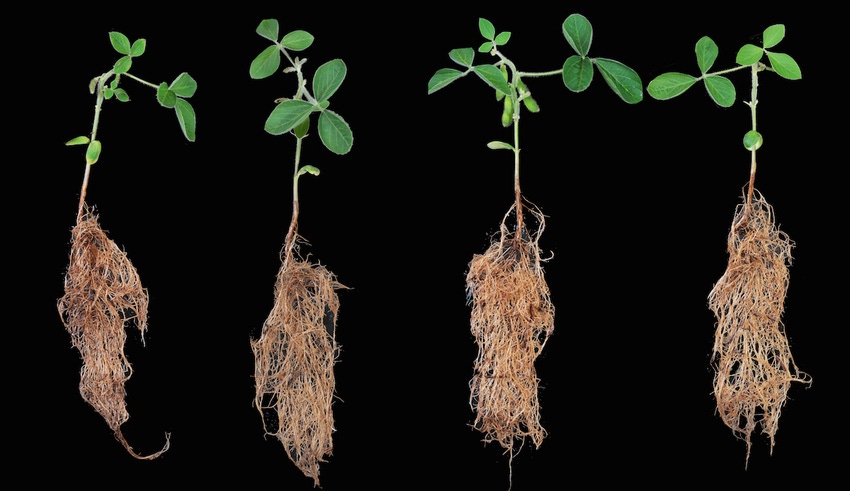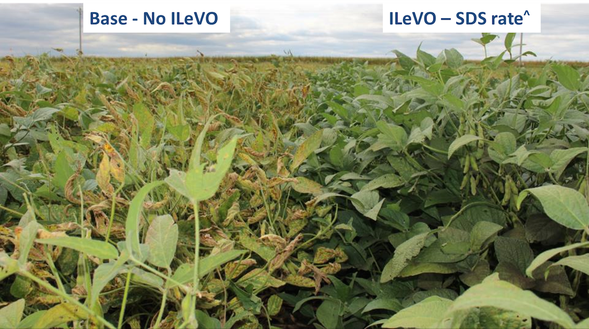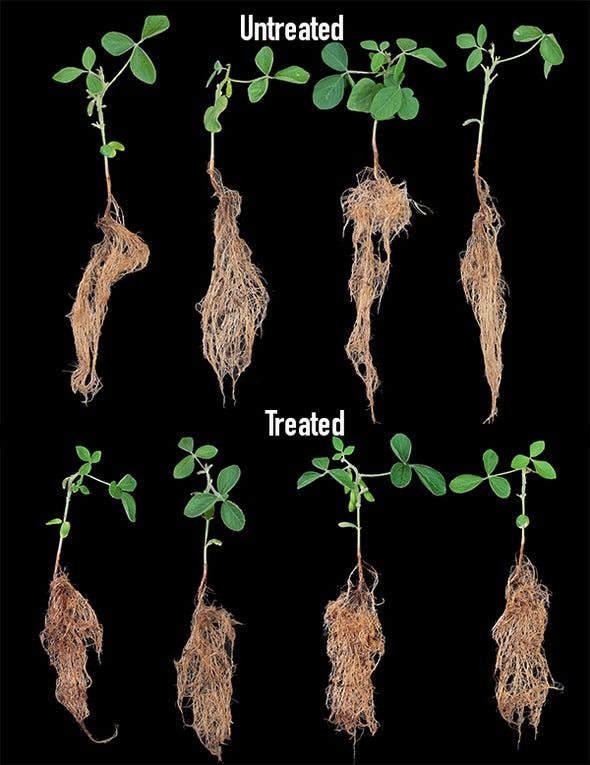April 16, 2015

Soybean cyst nematode (SCN) and sudden death syndrome (SDS) have long been considered synergistic pests. Soybean cyst nematode is thought to damage the roots, allowing Fusarium virguliforme to enter through the wound.
“Instead, Iowa State University (ISU) researchers, funded by the Iowa Soybean Association, have found that colonization sites of sudden death syndrome are not associated with nematode feeding sites,” says Leonor Leandro, ISU plant pathologist. “Sudden death syndrome takes advantage of tender emerging lateral root tips to enter plants.
“It is possible that sudden death syndrome enters wounds created when soybean cyst nematode females pop out of the roots,” he says. ”We are gaining a better understanding of how these two pathogens interact, with a lot of work still to be done to complete our understanding of what is going on.”
New products aimed at soybean cyst nematode (SCN) and sudden death syndrome are on deck for the 2015 planting season. Bayer CropScience’s ILeVO seed treatment offers a new adversary for SDS, while Syngenta’s Clariva Complete Beans present a new tool for SCN.
SDS: ILeVO
ILeVO, which was federally registered in December 2014, is securing state registrations so farmers can begin using it this spring.
“Early-season cool and wet weather in 2014 made SDS a problem from Canada to the Gulf Coast,” says John Carlson, Bayer CropScience business-to-business strategy manager and ILeVO product manager.
The SDS pathogen, Fusarium virguliforme, attacks as roots develop and seedlings emerge. “It begins with root rot and can cost growers 2 to 4 bushels per acre,” Carlson says. “In the foliar stage, SDS can take between 4 and 10 bushels per acre.”
The active ingredient in ILeVO, fluopyram, originally was tested as a systemic, broad-spectrum nematicide. But about five years ago in an SDS-infected field, “The fluopyram repeatedly showed very distinct efficacy on SDS, nematodes (including SCN), root knot and reniform nematodes and insects,” Carlson says.

The soybeans on the right were treated with 0.15 mg ai per seed of ILeVO. “The visual difference between ILeVO-treated varieties and non-treated checks can be dramatic,” says Daren Mueller, Iowa State University Extension plant pathologist. “Almost every time I walked into a field with SDS, I could point out the varieties that had ILeVO.” Photo: Bayer CropScience
On-farm trials
“SDS has been pretty intense here for about 15 years,” says Jeff Norton, Hull, Ill. His family farms about 10,000 acres of corn and soybeans on the Mississippi River bottom.
“Last year, 2014, was by far the most severe we’ve ever seen,” he says. “Cold and wet weather delayed soybean planting for a month after we planted corn.”
Daren Mueller, Iowa State University (ISU) Extension plant pathologist, has studied SDS for 10 years. “Almost every SDS outbreak has been driven by the amount of rainfall during the reproductive stages of growth,” he says.
Norton planted an identical, side-by-side comparison in an SDS-infected field, using ILeVO on one half of the test plot.
“As soon as we planted on May 9, a cold rain came through,” Norton recalls. To make sure the plot would be challenged, Norton irrigated shortly after planting.
By July, the visual difference was striking. “The treated beans had very little damage, just a touch on the upper leaves. The untreated beans showed damage on the entire plant,” says Norton, who intends to plant ILeVO-treated soybeans on half of his soybean acres in 2015.
In tests comparing more than 20 varieties with different seed treatments, Mueller found a 2- to 10-bushel-per-acre yield response from ILeVO-treated beans. “The anatomy of the plant makes systemic seed treatments more successful than contact fungicides,” he says.
SCN: Clariva Complete Beans
Syngenta launched Clariva™ Complete Beans, a nematicide, insecticide and fungicide seed treatment, in 2014.
Pasteuria nishizawae spores in the seed treatment attach to the cuticle of second-stage juvenile SCN, explains Dale Ireland, Syngenta technical product lead for corn and soybean Seedcare. “The spores produce a germ tube that penetrates and infects the nematode’s interior body, ultimately killing the pest.”
Sizing up Treatments
Nathan Baker of Waldron, Mich., Baker farms about 3,700 acres with his father and uncle. They follow a corn/soybean/wheat rotation on extremely variable yellow clay soils. Baker also operates a Syngenta Seed dealership.
Baker planted six test plots in 2014 comparing Clariva Complete Beans and CruiserMaxx soybeans with Vibrance insecticide/fungicide, which does not have the new SCN control component.

Untreated Group under Nematode Pressure (top) and Clariva Group under Nematode Pressure (bottom): “Pasteuria nishizawae spores in Clariva Complete Beans (bottom) attach to the outer layer of second-stage juvenile SCN,” says Dale Ireland, Syngenta technical product lead for corn and soybean Seedcare. “The spores produce a germ tube that penetrates and infects the nematode’s interior body, ultimately killing the pest.” Photo: Syngenta
“The Clariva Complete Beans averaged 1.58 bushels per acre more than the check variety, with yields ranging from 1.08 to 2.02 bushels per acre more than the check in every plot,” he says. “Clariva Complete Beans cost about $9 per acre more than CruiserMaxx beans with Vibrance. From what we learned in the plots, growers who have an SCN problem could double their money back from the treatment.”
Baker also likes that fact that the new nematicide in Clariva Complete Beans is a biological that does not require special handling or raise environmental concerns.
Partnering with varieties
“SCN-resistant varieties are good management options, but they are not a cure,” says Greg Tylka, ISU professor of plant pathology. “The situation lends itself to the possible addition of a seed treatment.”
Tylka was involved in two types of studies of Clariva Complete Beans last summer. The first were traditional, small plot (four 20-foot rows) replicated experiments at nine locations comparing Clariva Complete Beans with Syngenta’s CruiserMaxx Advanced with Vibrance seed treatment fungicide on the same SCN-resistant soybean variety.
“In essence, we were comparing the same base seed treatment with and without the new nematicidal component in Clariva Complete Beans,” Tylka says.
“There was a significant reduction in SCN reproduction in two of the nine plots with Clariva Complete Beans,” he says. “And, two of the nine plots of Clariva Complete Beans yielded 2.1 and 1.1 bushels per acre more than the plots with CruiserMaxx Advanced with Vibrance. � But the average yield advantage of .2 bushels per acre over all nine experiments was not significantly different.”
Tylka also partnered with the Iowa Soybean Association (ISA) to conduct large-scale trials of these two products on 15 farms, which are operated by members of the ISA On-Farm Network. The plots were one planter-width wide and 1,000 to 1,500 feet in length.
The Clariva Complete Beans yielded between 4.6 bushels per acre more and 1.2 bushels per acre less than beans with CruiserMaxx Advanced with Vibrance, averaging 0.8 bushel per acre more overall.
“We are seeing SCN-resistant soybeans slowly losing effectiveness,” Tylka says. “Almost all of them have the same set of resistant genes. The new Clariva Complete Beans may bring added SCN protection to help maintain the performance of resistant varieties.”
About the Author(s)
You May Also Like




